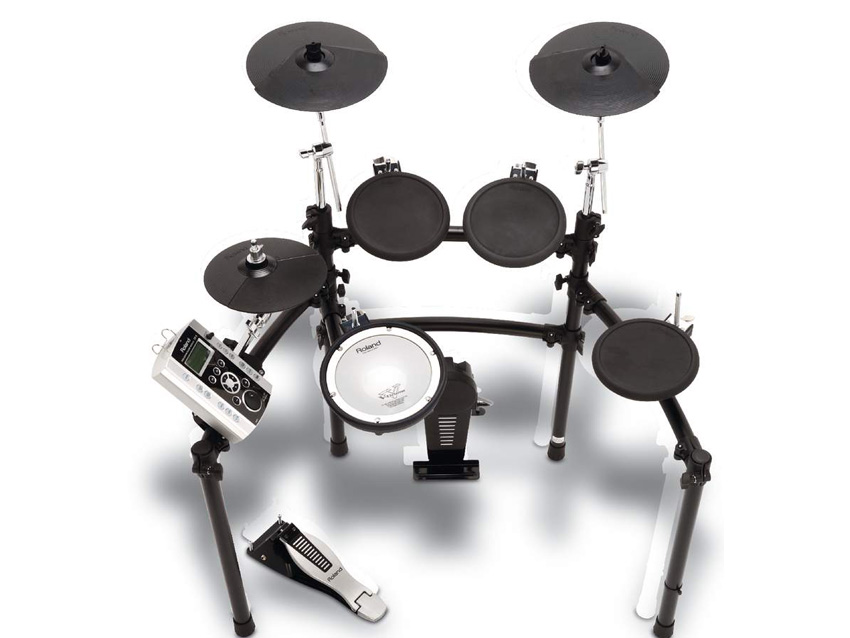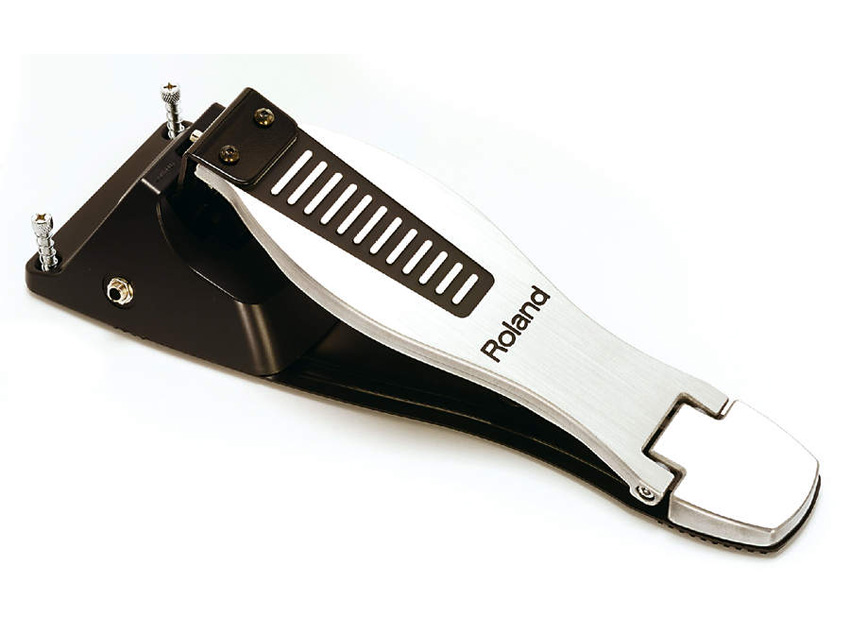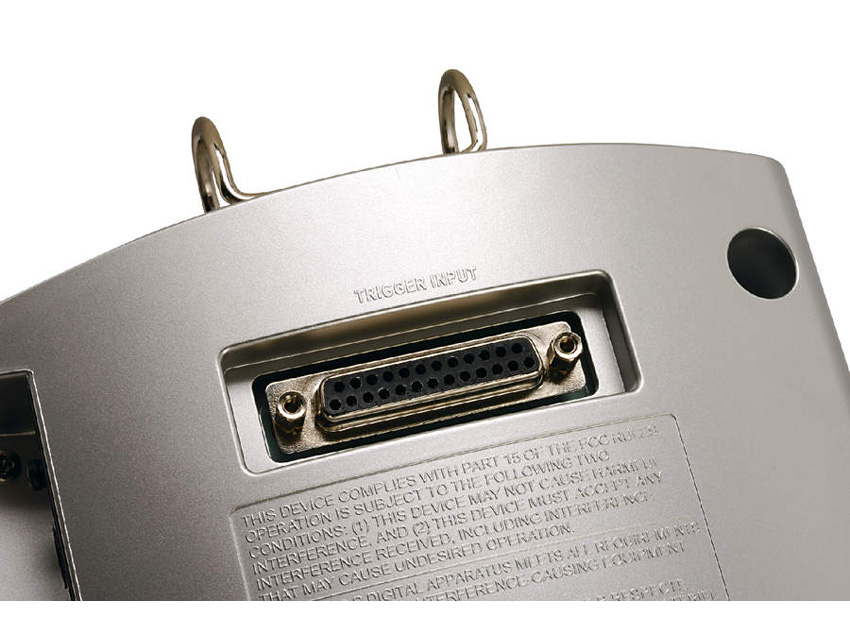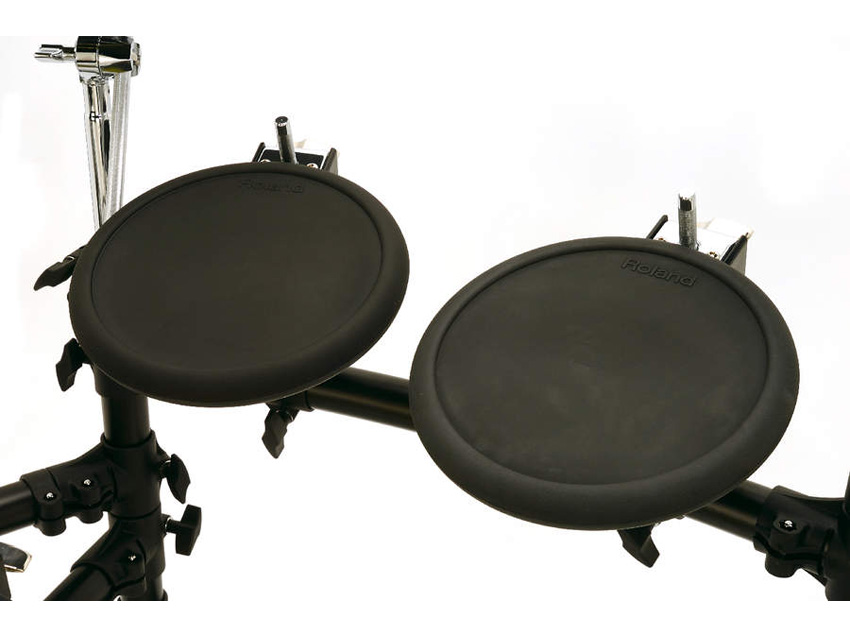MusicRadar Verdict
It´s hard to see what Roland could have done to make the TD-9K any better without significantly increasing costs here. Sure, a VH-11, bigger pads with mesh heads and the like would be lovely, but that´s what upgrades (or indeed the TD-9KX) are for. As the new breed of affordable but serious electronic percussion goes, the TD-9K makes a bold statement.
Pros
- +
A nice blend of the high-end and the affordable. Simple to use, extremely flexible rack. Powerful brain with a friendly interface.
Cons
- -
As ever, the preset sounds might not impress everyone. No mesh heads on the toms.
MusicRadar's got your back

Roland TD-9K

Roland TD-9K

Roland TD-9K

Roland TD-9K
However good (or otherwise) the Roland TD-9K proves to be, this is An Important Kit. As the mid-range offering from arguably the strongest name in electronic drum sets, this set-up assumes significance simply because a) if it's any good it'll be the rig to beat, and b) if it isn't, it'll allow others a slice of what's becoming an increasingly large pie.
So the new TD-9K has a lot resting on its shoulders - whether it proves up to taking on the mantle of its popular predecessor or not, you'll find out in a few short paragraphs.
Build
It's all very well getting worked up about flagship products like Roland's TD-20K and Yamaha's awesome DTXtreme III, but in the real world it's kits like the TD-9 that more regularly find employment with everyday players.
Designed to offer a blend of the high-end and the affordable, we've come to expect this middle ground to throw up kits that sound good, with reasonable editability and functions, and a playing feel that's a step-up from the entry-level stuff. The TD-9K aims to deliver on that latter point by sporting a simple but highly effective rack system with newly-designed cymbal arms and a mesh head snare pad to boot. That the rack hangs together very well and is super-simple to set up should come as no surprise - we've come to expect that of Roland. But touches like the new cymbal arms are a welcome addition.
A ball-and-clamp design allows for huge flexibility in positioning terms, and in a situation where the other elements of the kit are rather more 'fixed' than in the case of an acoustic set, anything that adds such options is valued. The mesh snare will also go down well in the marketplace. We're currently of the opinion that big rubber pads (of the ilk used by Yamaha for the DTXtreme III) can feel as good as anything; but when we're dealing with smaller pads - particularly where the snare is concerned - we'll still take a mesh head.
"The new Scope function is aimed at improving your accuracy and timekeeping, or at the very least drive you insane with frustration. Basically a live graphical representation of how close your strokes are to a metronomic click, Scope places dots on an on-screen grid as you play".
Of course the most significant aspect of the new kit is the TD-9 module itself, with its spanking new selection of sounds and friendly interface. The brain is filled with 520-odd sounds, 49 preset kits of various types and 50 songs with which to keep yourself from getting bored listening to the metronome. We'll come to discuss how the sounds impress shortly, but while we're here there are a couple of TD-9 features that also warrant a mention.
The first is the new Scope function, aimed at improving your accuracy and timekeeping, or at the very least drive you insane with frustration. Basically a live graphical representation of how close your strokes are to a metronomic click, Scope places dots on an on-screen grid as you play. It's a harsh illustration of how spot-on, or not, you are, and a useful practice tool. The screen display can be zoomed in as well, which makes Scope very easy to use when playing, no matter how animated you get.
The mid-range nature of the TD-9K means that we have to forego a couple of nice features that you'll find on other, pricier offerings. Chief amongst these is the hi-hat set-up, which comprises the FD-8 trigger pedal twinned with a little CY-5 pad. It actually works well, but the less-substantialthan-the-real-thing feel of the FD-8 obviously can't replicate the response of a proper hi-hat stand.
The good news is, however, that the TD-9 is compatible with Roland's VH-11 hi-hat, as used for the TD-12, so upgrading is easy when you feel the need.
Hands On
Any restrictions that the price-point of the TD-9K has placed on the designers are largely forgotten when it comes to playing the kit, though. The module is a sexy piece of gear, and contains a host of typically strong sonic offerings. As ever, some preset kits are more impressive than others, with particular favourites including the warm but poky Jazz Funk set and the 'standard' V-Tour Studio. The electro kits are, as ever with Roland, very convincing too - the 808 and 909 should be, of course, but others, like the minimal house collection, are fun and very funky.
There's a very useful amount of editing available on each kit, too. And although there's a degree of button-pushing involved in getting to the required editing page occasionally, the TD-9 is fairly self-explanatory, so the odd glance at the manual should get you through.
It's a simple affair, for example, to decide you'd like a bigger pair of hats on the Big Rock kit and go for 15"s, or 18"s even, just by dialling the data wheel. The same goes for bigger or smaller drums, and different shell materials - in short there's huge scope for either tweaking existing kits or coming up with your own.
EQ and effects are also a breeze to modify (and there is a fair amount of cavernous reverb on some of the standard kits - to impress 'instore' presumably), and while the TD-9 doesn't boast a dedicated 'kit mixer' on the front of the unit as per posher brains, the on-screen mixer is only a couple of presses away. Not quite as quick to make on-stage changes, but painless enough.
As far as response is concerned, the TD-9K certainly does enough to make it a thoroughly rewarding experience for those after an acoustic emulation to practise with. The combination of some very nice kit sounds, the feel of the mesh snare and tailor-able sensitivity settings get it close enough to feeling 'real' as to be eminently playable. Given its price, it's brilliant.
But it's the 'package' nature of electronic kits that makes them so appealing. An acoustic kit can't help train your left hand to be more accurate, or provide entertaining backing tracks to help practice sessions fly by. On this front, the TD-9 fares well too.
As always, metal-heads will despise the clunky synth guitars of the heavier tunes, but for those keen to work on their funk, soul, disco and pop chops, there's lots of amusement on board. And another ace up the TD-9's sleeve is its option for you to plug in a USB stick and play back MP3 files, so you don't have to hook up an iPod or suchlike (although this is an option too). Just raid your PC for your favourite, legally downloaded tunes, whack them on a stick and you're away.
MusicRadar is the number one website for music-makers of all kinds, be they guitarists, drummers, keyboard players, DJs or producers...
- GEAR: We help musicians find the best gear with top-ranking gear round-ups and high-quality, authoritative reviews by a wide team of highly experienced experts.
- TIPS: We also provide tuition, from bite-sized tips to advanced work-outs and guidance from recognised musicians and stars.
- STARS: We talk to musicians and stars about their creative processes, and the nuts and bolts of their gear and technique. We give fans an insight into the craft of music-making that no other music website can.
“A synthesizer that is both easy to use and fun to play whilst maintaining a decent degree of programming depth and flexibility”: PWM Mantis review
“I feel like that song had everything we needed to come back with”: Bring Me The Horizon’s Lee Malia on Shadow Moses, its riff and the secrets behind its tone, and why it was the right anthem at the right time
“I said, ‘Are we sure we can write a song about death?’”: The story of Mike + The Mechanics' classic No.1 The Living Years










